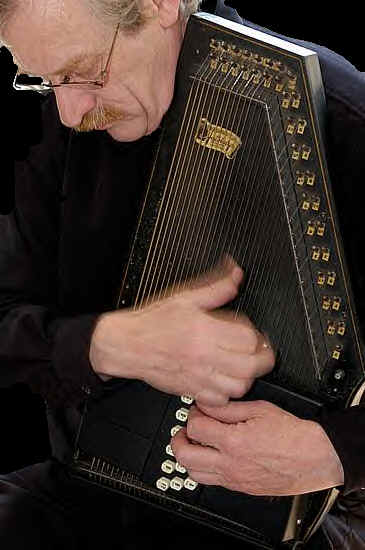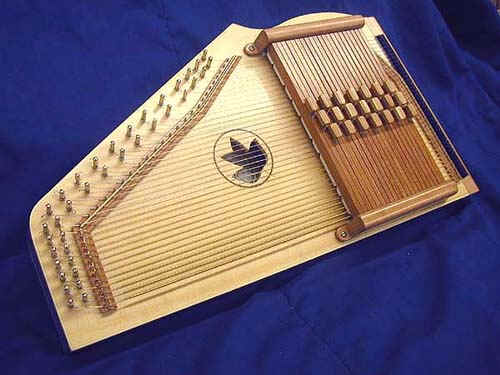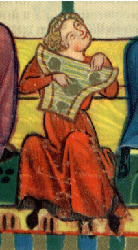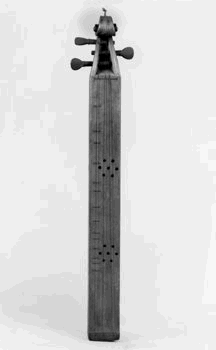![]()
![]()
 The
autoharp is an instrument I have known since my earliest childhood, but it was
only a few years ago that I began to take an active interest in it. I
would like to introduce it to you here.
The
autoharp is an instrument I have known since my earliest childhood, but it was
only a few years ago that I began to take an active interest in it. I
would like to introduce it to you here.
The picture on the right is of me with my old Oscar Schmidt autoharp (1958 vintage, the same model as played by Johnny Cash's beloved June Carter in the film "Walk the Line"), which I have upgraded from 12 to 21 bars. Click on the pic to hear me playing "The Skye Boat Song" on it (mp3 format).
But I am sure you are curious about this rather rare musical instrument.
Click on a question to find out the answer!
1.
What is an autoharp?
2. How do you play it?
3. Where does it come from?
4. What kind of music is it suitable for?
5. Where can you get sheet music for it?
6. Where can you get one?
7. OK - so the autoharp is a kind of zither?
For more information in the Internet, try these links:
|
Oscar Schmidt (autoharp manufacturer) |
![]()

An autoharp is a stringed instrument consisting of a flat, roughly harp-shaped wooden box about 2 feet long and 1 foot wide with many (nowadays usually 36 or 37) wire strings and a number (usually 12, 15 or 21) of spring-loaded cross-bars with felt pads for damping specific strings. Each bar gives you a different chord when you press it and strum the strings. So they are called chord bars.
![]()
Easy as pie - if you
practise long enough!
You press a chord bar and draw a plectrum or pick across the strings. And
you've got a chord! The felt pads damp the strings that do not belong to the
chord designated on the chord bar. You can learn a strummed 3-chord
accompaniment in minutes.
The autoharp is mostly played with picks on the right thumb and on 2, 3 or even 4 fingers. With these, a wide range of picking patterns are possible, to suit the character of the music.
The advanced technique on the autoharp includes melody playing. The simplest way to do this is to stop or end each strum at the desired note for the melody. Later, you can progress to picking the melody notes directly with the finger-picks, while the thumb and other fingers pluck the harmonies.
The pressed chord bar prevents the "wrong" notes that lie between the "right" notes from sounding if they are plucked inadvertently. This way, practised players can achieve an almost piano-like complexity of touch.
To make a long story short: simple as it is to play entry-level autoharp, it is a long way to the perfect solo performance. However, with the autoharp as with perhaps no other instrument, you can make a lot of attractive music for yourself and others at each stage along the way.
![]()
It was patented around 1880 by the luthier Carl Gütter in Markneukirchen, Germany, but as early as 1882 a German emigrant by the name of Carl Zimmermann took the idea to the USA. It was Zimmermann who coined the name "Autoharp" for the instrument. It became much more widespread in America than at home in Germany, and mail-order catalogues and door-to-door salesmen made it possible for the novel instrument to actually become a folk instrument in remote areas of the Appalachians.
In America, the autoharp was continually developed and improved, the last burst of innovation coming in the 1970s as a result of the folk revival of the '60s. So the modern autoharp is of North American origin.
![]()
4. What kind of music is it suitable for?
There is practically no autoharp literature as such, because 'harp music is usually improvised. The basis for improvisation can be any piece that you can hum or whistle: folk songs, pop ballads, Gospel songs, traditional songs, jazz standards, art songs, light classics, what have you...
Not only accompaniments, but also instrumental versions of these kinds of music can be arranged for the autoharp.
The autoharp feels
its limitations when music becomes harmonically too complex, or when keys are
required for which it has no ready-made chords.
The point is that the autoharp in its standard form has only major, minor and
dominant seventh chords at its disposal. With 21 chord bars, that means a
maximum of 7 chords of each chord type. The chords of one type (e.g. the
major chords) are arranged by the circle of fifths, e.g.: ...Eb, Bb, F, C,
G, D, A... The classical freedom of key is therefore limited.
Not only classical music often demands different chord types, e.g. diminished or augmented chords. In an accompanying role, the 'harp can often keep step even here, because it is often a note in the melody that turns a basic triad into a "moccha" chord.
For solo pieces, however, the 'harp in its standard configuration is sometimes challenged, usually in classical music or jazz.
It is therefore
normal practice for autoharpers to tailor their instrument to their personal
musical preferences.
The felt of the chord bars has to be renewed some time anyway. A felt
strip is glued under the chord bar, and notches are cut in it to open up the
notes of the chord. And while you are about it, you can of course
"cut" different chords.
One player may want a lot of 4-note chords, and is prepared to further
limit the variety of keys to get them. Another, who enjoys playing with
wind players, will want more "flat" keys and will sacrifice
"sharp" keys to get them. 'Harpers who play with Bluegrass
musicians will tend to go in the other direction. And the relative
positions of the major and minor chords are often altered to make certain kinds
of music easier to play.
So, if your don't want everything at once, the autoharp can be set up for almost any kind of music without much effort. One might say, "Show me how your 'harp is configured, and I'll tell you what kind of music you play!"
![]()
5. Where can you get sheet music for it?
As I pointed out above, there is very little "literature" for the autoharp. But don't worry - there's plenty of sheet music!
Most of the pieces
that come into consideration as autoharp arrangements are to be found in
song-books or sheet music with chord symbols. These are intended for
guitarists and accordionists, and consist of chord names printed over the stave,
e.g. C, G7 or Am.
Fortunately, similar chord names are printed on the chord bars of the autoharp,
so that you can transfer the arrangement directly to the 'harp. All you
have to do then is to pluck the strings in a suitable rhythm.
When you have become a more advanced player, and are making the transition to melodic playing, you will have to change chords more frequently than shown in most guitar song-books, in order to get all the notes of the melodies - but by this time all that accompanying will have made your chord changes quick and easy!
![]()
With reference to Germany - and in fact Europe in general - this is a difficult question to answer. Although I have enquired in all the music shops I know or have stumbled over in my travels in Germany, I have found only one that sells autoharps: Berthold & Schwerdtner in Stuttgart.
The only German maker of autoharps (under the brand name of "Harfenzither" or "Chordharp") is the Hopf company in Vogtland. Their Homepage has a brief description of the instrument (under "Chordharp").
For the autoharp supply situation in the UK, I would recommend you to consult the homepage of "UK Autoharps", an autoharp society in England that is working to spread the popularity of the instrument in the British Isles.
If you are not in the privileged position of having a shop selling autoharps near you, the best place to find one is in the Internet. E-bay always has a several autoharps on offer - though seldom in Europe or the UK. So it is wise to click on "Advanced search" in e-bay, and select "Items located in -> Any country". In the case of a technical piece of equipment like an autoharp, it is appropriate to ask the seller a few direct questions, and ask for some clear photos . I have already bought three very usable 'harps this way!
But whether in a
shop or in the Internet, a good buyer is an informed buyer. A good source
of information on manufacturers, models and potential pitfalls is the "Cyberpluckers"
forum in the Internet.
Information on the most common models can be found on the homepage of the
biggest US autoharp manufacturer, Oscar
Schmidt International.
![]()
7. OK - so the autoharp is a kind of zither?
The answer to this question is a definite "yes and no!"
No, the autoharp has nothing in common with the widely known zither of the Alps, except for a certain, superficial visual similarity.
The modern autoharp looks like this (note the chord bars on the right):

...the modern concert zither looks like this (note the fretted fingerboard at the top):

Now, horses and cows have some similarities: both are large, and have hooves and short hair, which is mostly brown, black or piebald, and both eat grass.
However, cows have
horns, horses have manes; cows are for milking, horses for riding.
Similarly, the zither has a fretboard, the autoharp chord bars;
the zither has separate melody and accompaniment strings, whereas the strings of
the autoharp are tuned to a through-going scale. This means, of course,
that the respective playing techniques are radically different.
Yes, because the term "zithers" is used in organology to designate all stringed instruments on which the strings are stretched from one end of a wooden box to the other, and to distinguish them from the "harps" with their open frame, and the "lutes" with their narrow neck. In this sense, the dulcimer, the Japanese koto, even the piano and harpsichord, are "zithers". So, of course, are the Alpine zither and the autoharp. (In the same way that cows and horses are "ungulates", or hoofed animals!)
By the way, with
ungulates we distinguish between cloven-hoofed (e.g. cows) and single-hoofed
animals (e.g. horses). Similarly, in the case of the "zithers", we
distinguish between "fretboard zithers" (e.g. the Alpine zither) and
"fretless zithers" (e.g. the autoharp).
The "genealogy" of the two instruments will perhaps make the
difference clear:

Technically speaking, the autoharp is a grand-child of the psaltery,
a box-shaped medieval instrument that was strung like a harp (see illustration
on the right).
From about the beginning of the modern era, in northern Russia, the psaltery was
no longer plucked with both hands. Selected strings were damped with the pads of
the fingers of the left hand, and the right hand plucked or strummed the
undamped strings. The instrument that emerged from this development was
the gusli (photo on the left), whose shape was adapted to the new
playing technique. And it is this left-hand damping technique that was auto-mated
on the auto-harp!
 The
ancestor of the zither was the German Scheitholt (photo on the
left: an example from around 1800), a long, narrow instrument with one melody
string that was stopped against a fretboard, and two open drone strings. All the
strings were strummed to give a bagpipe-like effect (diatonic melody with a
drone).
The
ancestor of the zither was the German Scheitholt (photo on the
left: an example from around 1800), a long, narrow instrument with one melody
string that was stopped against a fretboard, and two open drone strings. All the
strings were strummed to give a bagpipe-like effect (diatonic melody with a
drone). 
This simple instrument was given more and more strings to enhance its volume. At
the same time, the body became wider (photo on the right, 18th century), and the
instrument inherited the name of "Zither" from another plucked,
fretted instrument , which had meanwhile become obsolete (the German word
"Zither" formerly meant "cittern"). In the early 19th
century, the accompaniment strings became even more numerous, then they were
arranged on an ingenious principle that allowed proper harmonies, and were
plucked rather than strummed, and the fretboard was made chromatic (photo on the
left).  In
the middle of the 19th century, the now large number of accompanying strings
were arranged to follow the circle of fifths, and the modern concert zither was
born (see above)!
In
the middle of the 19th century, the now large number of accompanying strings
were arranged to follow the circle of fifths, and the modern concert zither was
born (see above)!
There is an illustrated history of this development on the Internet page of the University of Leipzig at "studia instrumentorum".
In the case of the autoharp, there is no such uninterrupted pedigree. It was patented around 1880, the inventor incorporating historical features (box-shaped body, damping technique...) and adding his own actual technical invention - the chord bar. The history of this invention is told very well in a paper by Ivan Stiles in the Internet.
In short: The evolution of two fundamentally different stringed instruments has led to a certain similarity in size and shape; the tunings and the playing techniques, however, have remained fundamentally different!